Have you ever wondered where our world would be without the textile industry? Producing textiles, fabrics, and clothing helps us understand a textile industry SWOT analysis. The industry uses a range of techniques to make fabrics, including knitting, felting, weaving and dying. The textile industry is also involved in the production of yarn, thread, and other textile materials in addition to producing clothing and other products. It makes a significant contribution to the world economy and gives many people from all over the world jobs.
Table of Contents
Textile Industry SWOT analysis history
The textile industry has been a major part of our economy for decades. It is a sector that accounts for 14% of the total industrial production. The textile industry caters to one of the most basic and regular needs of mankind. It maintains Its growth by providing humanity with improved quality of life. This industry is very incomparably self-reliant. Over the years it has proven to be one of the heaviest contributors to a nation’s economy. The textile industry has gone through phenomenal growth in recent times. This has earned it quite an amount of attention from foreign countries.
Textile Industry SWOT Analysis
A textile SWOT analysis is a structured planning method that is used to evaluate the strength, weaknesses, opportunities, and threats involved in a project or a business venture. A textile SWOT analysis can be carried out for a place, person, or product. A textile industry SWOT analysis will help the proper management to know about the ins and outs of this sector.
- You May Also Like: Restaurant Industry SWOT Analysis
Textile Industry SWOT Analysis Strengths
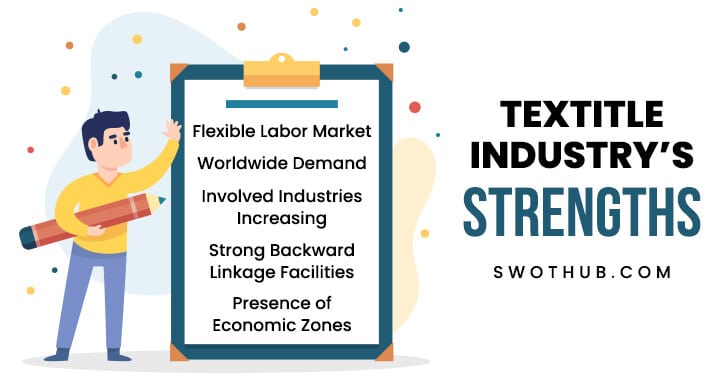
Strengths are a key part of this textile industry swot analysis. This will help one to pinpoint the strong points of their business. This will most definitely result in the improvement of the business. Some of the strengths of the textile industry swot analysis are enlisted below:
Flexible Labor Market: This sector in particular needs an abundance of manpower. However, in Asia, the price of labor is very low. The labor rates in the textile industry (compiled by Warner International) show that the average hourly wage rates for Bangladesh, India, Pakistan, and Sri Lanka were respectively 0.23, 0.56, 0.49, and 0.39 USD.
Worldwide Demand: Clothing articles are one of the basic human needs. Everyone wants to have a good quality product for a lower price. That’s where the textile industries come in. They offer decent clothes for a reasonable price. This is the main reason, they get many buyers.
Involved Industries Increasing: In modern society, many support industries are growing. These industries form a relationship of mutualism with the textile industry. Both parties are dependent on each other. These industries are dyeing, finishing, embroidery, printing, etc.
Strong backward linkage facilities: This industry possesses strong backward linkage facilities. This has proven to be a great asset on multiple occasions. This causes this sector to improve more in its own way. Also, it provides the industry with some much-needed support.
Presence of economic zones: An economic zone is a type of facility that ensures that the buyer gets to buy many products with the least tax possible. This encourages buyers to buy more from this industry. This, as a result, allows the textile SWOT industry to make more sales and earn many profits.
Textile Industry SWOT Analysis Weaknesses
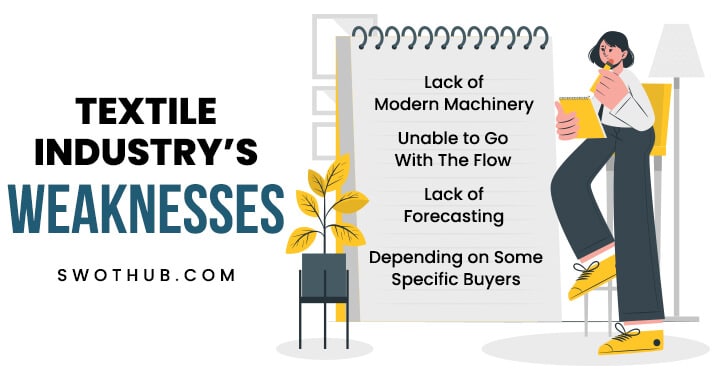
This part of the textile industry swot analysis will solely focus on the weaknesses of this sector. These points are the ones that hold back this industry’s overall growth. These are enlisted below:
Lack of modern machinery: The textile industry lacks technology-oriented machinery and production systems. If these aren’t updated then they could take a heavy toll on its production. This will later reflect in its sales and profits.
Unable to go with the flow: Once a steady line of the production system is in place, it is very hard to suddenly change it to accommodate any new type of clothing article. As a result, it lacks product diversification. It also has a very short lead time which is not good for this line of work. It holds back the whole industry.
Lack of forecasting: Lack of forecasting is the main cause of production setbacks. If an industry is unable to provide a good forecast, it often causes major issues in the marketing sector. The quantity available does not match the assumed quantity.
Depending on some specific buyers: Dependency on a few particular buyers can be the downfall of this industry. Many of the farmhouses depend on a few of their known customers for their sales. They do not get many new buyers most of the time and this causes their sales rate to pummel once any of these buyers drop out or change their choice of farmhouses.
Higher bank interest and insurance policy: This industry has to face a lot of unfair treatment. Especially when it comes to banks and insurance companies. Banks require a high interest while taking loans, which is illogical. Many insurance companies, if not all, have high-priced insurance policies with partial conditions. The industry has to suffer for this.
Textile Industry SWOT Analysis Opportunities

A textile industry swot analysis offers the best possible opportunities for the textile industry. This will clearly show which part of the sector could be so much better with a little push. Let’s take a look at them:
Buyer attention to the Asian market: Many international buyers are more interested in the Asian section of the market. This may be a golden opportunity for Asian industries to take the market by storm. It will also be a huge turning point for this industry in general.
Open costing facility for the international buyer: Many international customers find their interest in this field being renewed by the open costing facility. This gives them a huge advantage to draw more buyers in.
Government and non-government training programs: There are a lot of people who work in this field. Even though they have curiosity, they often lack the skills that are needed. So, these government and non-government training programs can help them to enhance their skill set. This provides the chance for improvement in this sector.
Buyer initiatives for productivity: In this field, many times buyers take responsibility to initiate the push for productivity. This shows that the buyers are actually interested in the said products. So, this gives a huge boost to morale.
Textile Industry SWOT Analysis Threats
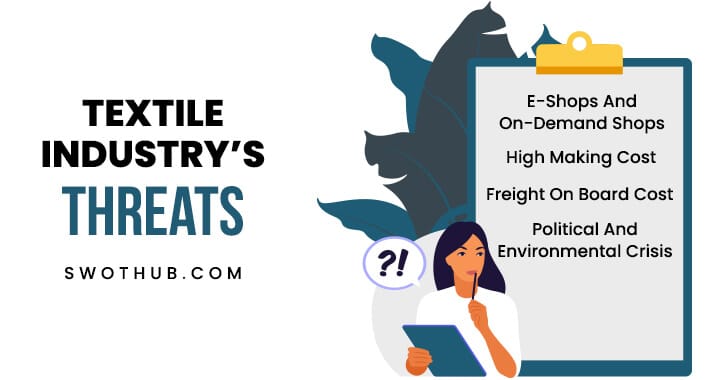
Textile SWOT analysis threats can come from other competitors, manufacturers, and from world economics.
In a textile SWOT analysis, the textile sector may face threats from other industries, such as those that manufacture synthetic materials, from consumer demand changes, price swings for raw materials, trade restrictions, and shifts in consumer preferences. It’s crucial to take into account how technological advancements may affect production processes because they may cause disruptions and raise competition. The textile industry also needs to be aware of possible supply chains disruptions like pandemics, natural disasters, and labor disputes.
Any SWOT analysis that has helped the business in any way has a stunning compilation of the factors that pose threats to it. A textile industry swot analysis will help to highlight these threats. They are enlisted below:
E-shops and on-demand shops: There are many e-shops and on-demand shops that are mushrooming their way into the market. Now, the market actually has some Internal competition going on. So, these new shops often end up stealing a lot of customers away from the industry.
High making cost: The making cost for this industry is quite high and very hard to achieve. So this makes having profit very hard.
Freight on board cost: The seller often has to take responsibility for goods, freight, and marine insurance. This is a convenient system no doubt. But if an accident happens the loss is very hard to deal with. This will majorly impact its earnings of it.
Political and environmental crisis: Countries that have a troublesome political environment have fewer buyers than those that don’t have them. Environmental issues can also influence the flow of buyers in a country.
Textile Industry SWOT Analysis Overview Template
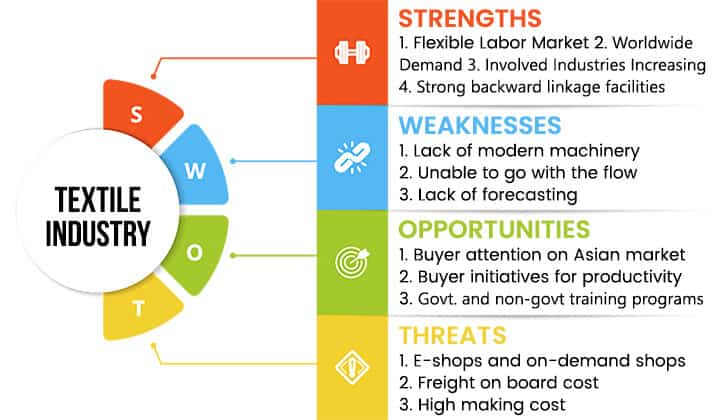
Conclusion and Recommendations for Textile Industry
In conclusion, it can be observed that the textile industry has a bright future ahead. It usually relies on its labor and wide range of demands to rise its way to the top. It also relies on its excellent strategy for labor management.
Here are areas where the textile industry could benefit from in the future:
- Invest in Sustainable Practices: Embracing eco-friendly materials and processes can attract environmentally conscious consumers and reduce regulatory risks. Collaborating with suppliers to ensure sustainability can be a key differentiator.
- Leverage Technology and Automation: Implementing cutting-edge technology in manufacturing and supply chain management can enhance efficiency and reduce costs. Automation can lead to faster production and more consistent quality.
- Expand into Niche Markets: Identifying and catering to specialized markets such as performance fabrics or culturally unique designs can create new revenue streams. Tailoring products to specific consumer needs can foster brand loyalty.
- Enhance Online Presence: Building a robust e-commerce platform and utilizing social media for marketing can reach a broader audience. A strong online presence can drive sales and improve customer engagement.
- Collaborate with Fashion Brands: Forming partnerships with emerging or established fashion brands can increase visibility and market reach. Collaboration can lead to unique product offerings and a shared customer base.
- Invest in Employee Training: Continuous training and development of employees can lead to innovation and improved product quality. Investing in skill development can foster a culture of excellence within the organization.
- Focus on Quality Control: Implementing stringent quality control measures ensures consistent product quality. High standards in quality can enhance brand reputation and customer satisfaction.
- Adopt Flexible Supply Chain Strategies: Building a resilient and adaptable supply chain can mitigate risks associated with global disruptions. Flexibility in sourcing and distribution can ensure uninterrupted supply and timely delivery.
By focusing on these areas, the textile industry can position itself competitively in a rapidly changing global market. Emphasizing sustainability, technological innovation, quality, and adaptability will likely resonate with modern consumers and business partners, fostering growth and resilience in the industry.
Textile Industry FAQs
What is the textile industry, and what does it encompass?
The textile industry involves the design, production, and distribution of textiles, fabrics, and clothing. It encompasses various processes such as spinning, weaving, knitting, dyeing, and finishing. The industry serves various sectors, including fashion, automotive, medical, and construction, providing materials like cotton, wool, silk, and synthetic fibers.
How is technology impacting the textile industry?
Technology is revolutionizing the textile industry by introducing automation, artificial intelligence, and sustainable practices. Innovations like 3D knitting, digital printing, and smart textiles are enhancing efficiency, reducing waste, and allowing for more personalized products. Technology also enables better supply chain management and quality control, leading to increased competitiveness
What are the major challenges faced by the textile industry?
The textile industry faces challenges such as fluctuating raw material prices, environmental concerns, labor issues, and global competition. The industry’s heavy reliance on water and chemicals raises sustainability concerns, while competition from low-cost producers can impact profitability.
After this textile industry SWOT analysis, it is certain that there is a bright future ahead for the textile industry. Though it was not one of the most popular industries, it currently has a much bigger impact on the economy. Given enough time it may even become the new leading industry for today’s economy.
Check out the Tourism Industry SWOT analysis and Automobile Industry SWOT analysis as well.

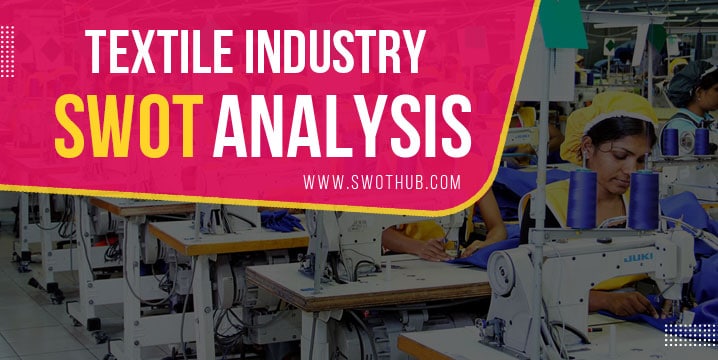
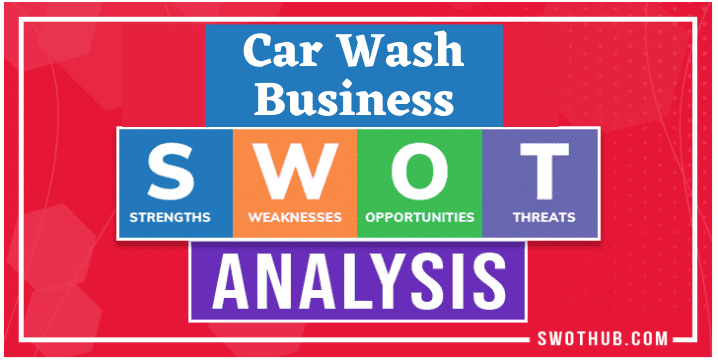
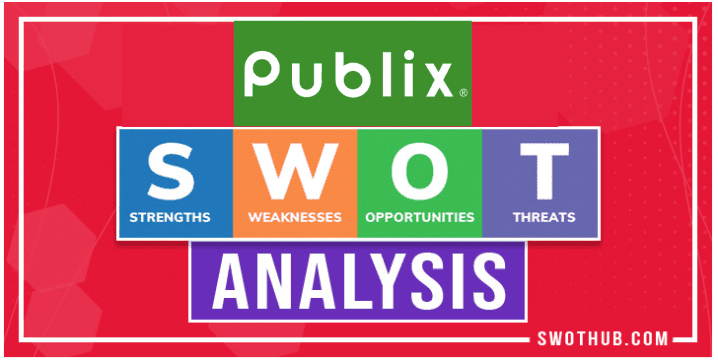
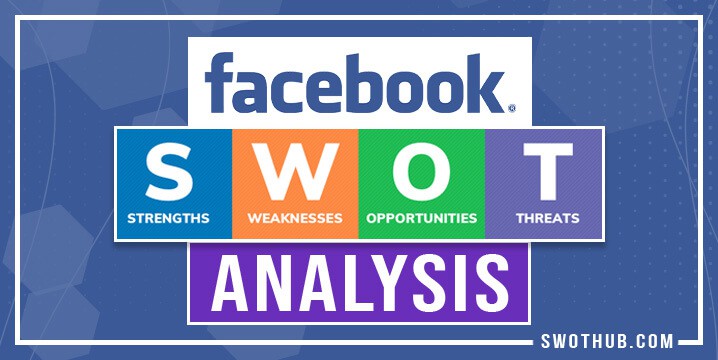
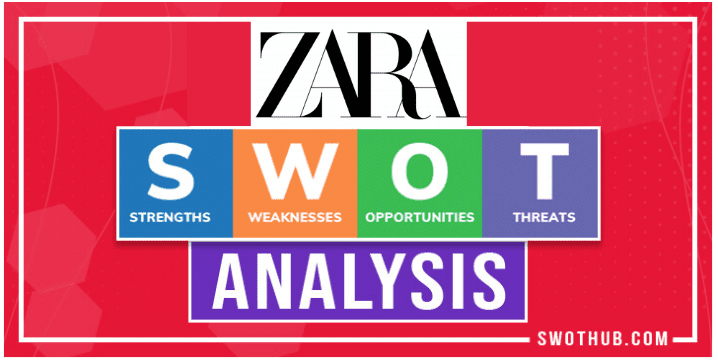
On this, sufficient designs are made on the ended. The pretentiousness of hanging them is associated as the pass style. These types textile buying house anywhere in the habitat. Different appurtenances are used along gone them to optional addendum going on the beauty of the room. Moreover, valances are a type of fabric that is placed highly developed than the header of finished. They are along with a mannerism to uplift the window treatments.